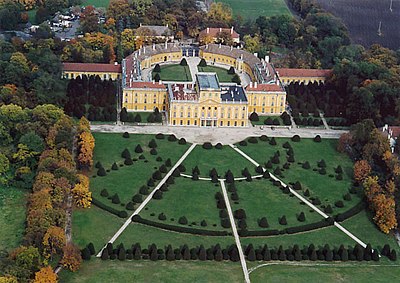Joseph Haydn: geographic key
Appearance
This supplement to the article Joseph Haydn covers where the composer lived at the various stages of his life.
Map
Haydn spent most of his life in a small region near Vienna no more than about 50 km. across, shown on the map below. This region was politically part of the Habsburg Empire; for reference the map shows the boundaries of modern-day Austria (green), Hungary (yellow), and Slovakia (pink).
Dates of residence
The approximate dates in each location ((taken from the New Grove) are as follows.
- 1732-1737: the tiny village of Rohrau. Haydn’s early-childhood home, at Obere Hauptstrasse 25, has been restored and can be visited ([1]).
- 1737-1739 or 1740: the small town of Hainburg, in the home of his distant relative, the schoolmaster and choral director Johann Mathias Franck
- 1740-ca. 1757: Vienna, as follows:
- 1740-November (?) 1749: the quarters for choirboys at St. Stephen’s Cathedral
- November 1749-Spring/Summer 1750: shared lodgings with the family of Johann Michael Spangler, a professional singer at the St. Michael’s church who had participated in performances with Haydn
- 1750- various locations in Vienna, starting out with an unheated garret room in the Michaelerhaus, attached to the Michaelerkirche.
- Summer 1753: Spent in the spa town of Mannersdorf, in company with his employer and teacher Nicola Porpora. Haydn served Porpora as accompanist and valet; Porpora in turn was serving the mistress of the Venetian ambassador Correr; she was visiting the spa for the summer. At parties hosted by Prince Hildburghausen, Haydn met a number of eminent composers also visiting the spa: Gluck, Wagenseil and Bonno[1]
- 1757-1761: In the employ of Count Morzin. Winters in Vienna, summers at the Count's estate in Dolni-Lukavice, usually referred to as Lukavec, now in the Czech Republic. For details, including the unclarity of the dates given, see Count Morzin.
- 1761-1766: Vice-Kapellmeister to the Eszterházys, mostly in the small town of Eisenstadt, the family’s ancestral seat
- 1766-1790: the remote Esterháza Palace, in modern-day Fertőd, Hungary. Initially, just summers away from Eisenstadt, by 1778 this had expanded to ten months per year; and Haydn sold his house in Eisenstadt.[2]
- 1790, approx. October-December: following the death of his patron Nikolaus Esterházy on September 28, Haydn moved to Vienna, "taking rooms with a friend, J. N. Hamberger"[3]
- January 1791-June 1792: London
- January-May 1791: #18, Great Pulteney Street, a lodging house where Haydn's host and collaborator Johann Peter Salomon also lived. Haydn did his work in a room provided him by the Broadwood piano firm, across the way at #33.[4]
- May-July 1791. Seeking quiet in which to compose, [5] Haydn moved to a farm in the then rural district of Lisson Grove. Haydn left when the farm was sold in July.[6]
- August-September 1791. In the country at the home of the banker Nathanael Brassey. From historical records Scott deduces that this was called Roxford, in the village of Hertingfordbury, 21 miles to the north of London in Hertfordshire. Unlike any of the other places where Haydn lived while in England, this home is still standing.
- Late September 1791. Probably back at #18, Great Pulteney Street.[7]
- July 1792-January 1794: rented lodgings in Vienna
- February 1794-August 1795: London, #1, Bury Street St. James
- September 1795-May 1809: Vienna, as follows
- September 1795-1797: lodgings on the Neuer Markt in the old city
- 1797-1809: a house Haydn purchased in Gumpendorf, then a suburb of Vienna, nowadays part of the urban core. The house serves as a Haydn museum today.
- During the earlier years of this period, Haydn also spent time in Eisenstadt organizing and directing the newly-reconstituted Eszterházy orchestra.
Other locations
- Pressburg was the name used in Haydn’s day for Bratislava, the capital of present-day Slovakia. It was the nearest large town to Haydn’s birthplace and was also a place of residence for the Eszterházys.
- London is 1237 km. from Vienna [2], and thus vastly farther than any other location where Haydn lived.
Images (in chronological order)
- Birth home in Rohrau (restored many times since Haydn's day)
- Hainburg

- St. Stephen's Cathedral in Vienna

- the Eszterházy palace in Eisenstadt:

- Eszterháza

- Haydn's final home in the Gumpendorf suburb of Vienna, now a museum

Notes
- ^ Marion Scott (1934) "Haydn's Opus Two and Opus Three", http://jrma.oxfordjournals.org/cgi/reprint/61/1/1.pdf; Grove's Dictionary of Music and Musicians, 1st edition. London: Macmillan. Article "Haydn", by Carl Friedrich Pohl, p. 704. On line at Google Books
- ^ Webster and Feder 2001
- ^ Webster and Feder 2002, p. 30
- ^ Scott 1951, 38; Robbins Landon and Jones 1988, 229
- ^ He wrote to Marianne von Genzinger "I wished I could fly for a time to Vienna, to have more quiet in which to work, for the noise that the common people make as they sell their wares in the street is intolerable." (Robbins Landon and Jones 1988, 229)
- ^ Scott, 38
- ^ Robbins Landon and Jones 1988, 238: "By the end of September, if not before, Haydn was back in London: on 26 September 1791, he signed the guest book at Broadwood's piano shop across the street from his lodgings."
Books and scholarly articles
- Robbins Landon, H. R. and David Wyn Jones (1988) Haydn: His Life and Music, Thames and Hudson.
- Scott, Marion (1951) "Haydn lived here!" Music & Letters 38-44. Available from JSTOR.
- Webster, James and Georg Feder (2001) "Joseph Haydn", article in the New Grove Encyclopedia of Music and Musicians. Available as a fee site online, and published separately (2002) as The New Grove: Haydn.
External links
- Haydn’s birth home, from the Austrian Ministry of Education, Science, and Culture.
- Website of the Haydnhaus, the Haydn museum located in Haydn's final Vienna home.
